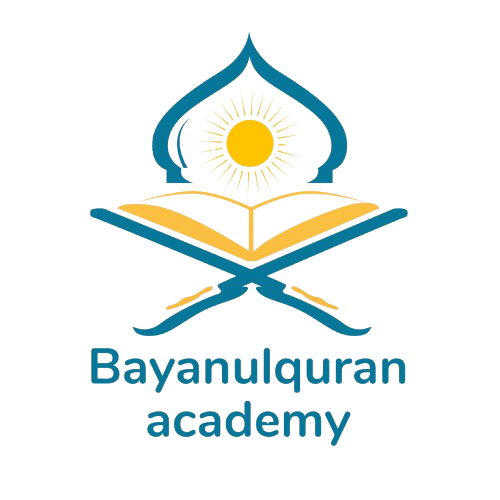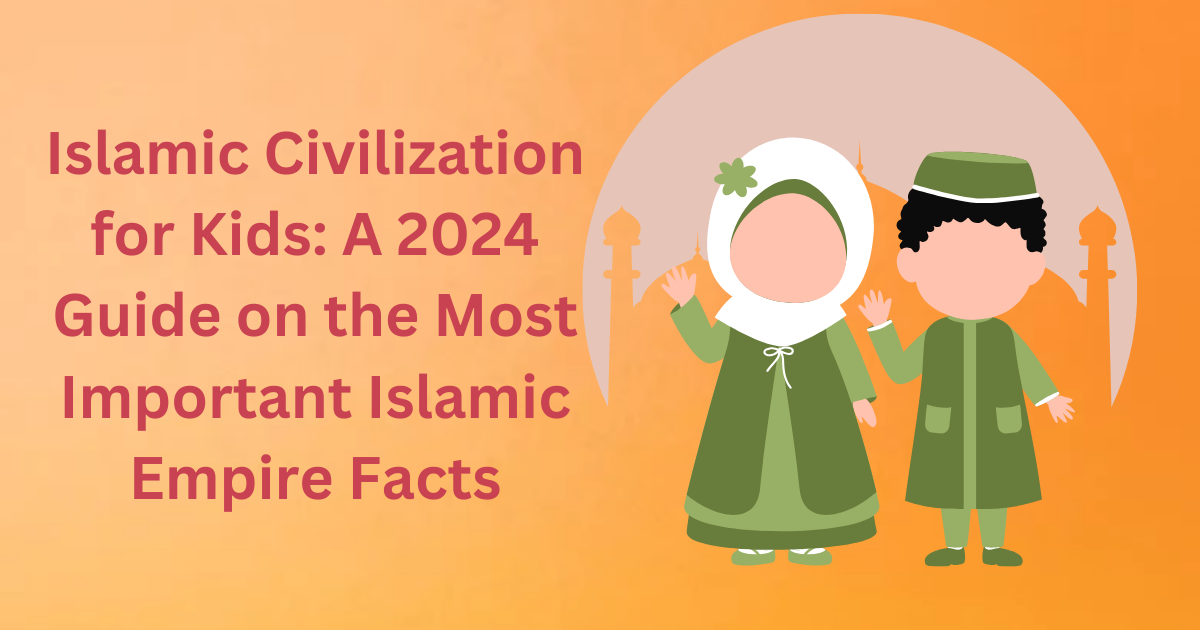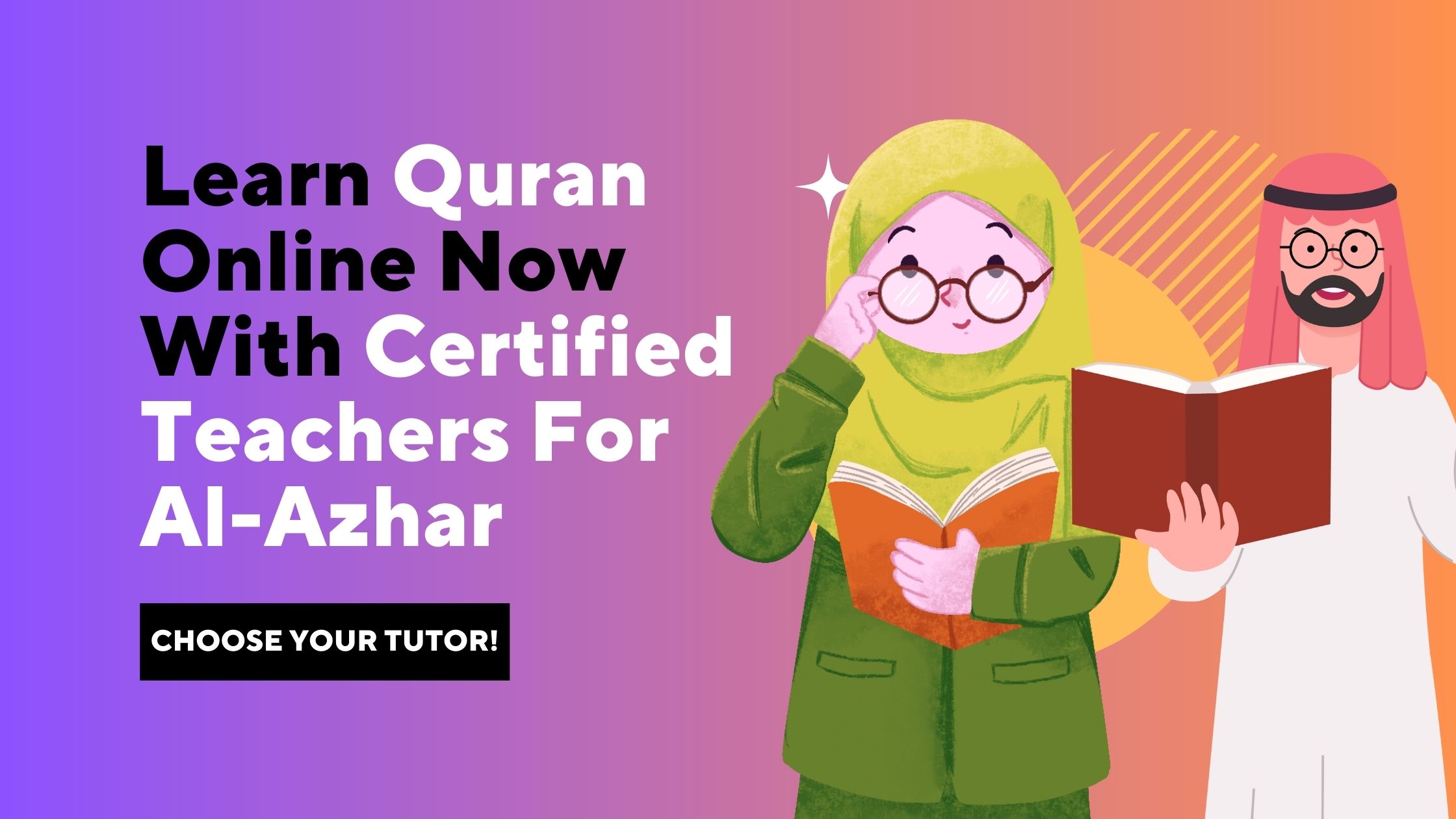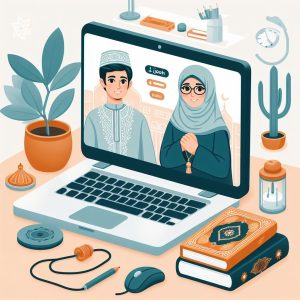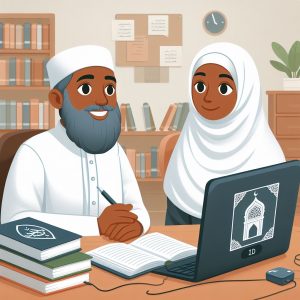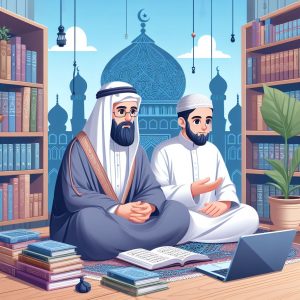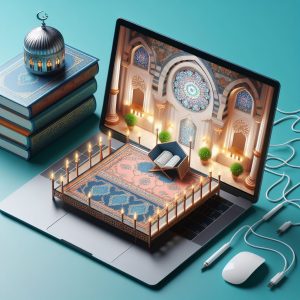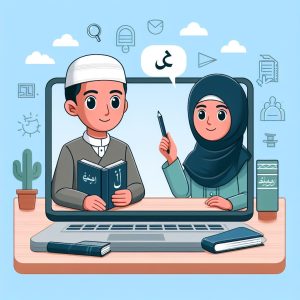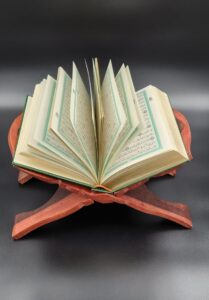Introducing Islamic civilization for kids is not merely a lesson in history; it’s an invitation to explore a world of knowledge, creativity, and cultural pride. By teaching them about the Islamic Golden Age, we connect them to a legacy of intellectual brilliance and inspire a lifelong love for learning.
Through stories, comparisons, and interactive activities, we can make Islamic civilization for kids an exciting journey that not only strengthens their identity but also encourages them to contribute to the world with the same spirit of innovation and discovery that defined their ancestors.
Imagine a world filled with wonder and wisdom; a place where people were excited to learn, invent incredible things, and share heartwarming stories. This is Islamic civilization’s universe!
In this article, we will talk about Islamic civilization for kids with special emphasis on the Golden Age of the Islamic Empire. We will also discuss some interesting facts about the Islamic Empire which you can share with your kids in a manner that is appropriate for their age. Then, we will give some tips and guidelines about how to teach Islamic civilization to kids.
Table of Contents
What is Islamic Civilization?
Islamic civilization is a term used to describe the rich cultural, scientific, and intellectual heritage that developed in the Muslim world. This civilization flourished in regions including the Middle East, North Africa, Spain, and parts of Asia. It was characterized by a commitment to learning, innovation, and the integration of diverse cultural influences.
Islamic civilization saw tremendous growth in various fields such as science, mathematics, medicine, literature, and art. It laid the foundation for many modern advancements and played a crucial role in the preservation and dissemination of ancient knowledge.
Key Features of Islamic Civilization
Islamic civilization was marked by several key features that contributed to its remarkable achievements and lasting influence. Here is a summary of its key elements:
1. Cultural Diversity:
The Islamic empire was home to people from various ethnic backgrounds and religions, including Arabs, Persians, Turks, Berbers, and others. This diversity contributed to a rich cultural tapestry and the exchange of ideas.
2. Centers of Learning:
Cities like Baghdad, Cairo, and Cordoba became major centers of learning. Libraries, universities, and academies, such as the House of Wisdom in Baghdad, played crucial roles in preserving and expanding knowledge.
3. Scientific and Technological Advancements:
Islamic scholars made significant contributions to fields such as mathematics, astronomy, medicine, and engineering. Their work laid the foundation for many modern scientific principles.
4. Art and Architecture:
Islamic art and architecture are renowned for their intricate designs and innovative structures. Notable examples include the Alhambra in Spain, the Great Mosque of Cordoba, and the minarets and domes that define Islamic architecture.
5. Trade and Commerce:
The Islamic empire was a hub of trade and commerce, establishing extensive trade networks that connected the East and West.
6. Innovations in Engineering:
Muslim engineers developed advanced technologies in water management, mechanical devices, and architecture.
7. Literature and Poetry:
The Islamic world produced a rich body of literature and poetry, reflecting the diverse cultural and intellectual heritage of the civilization.
8. Preservation of Knowledge:
Islamic scholars preserved and translated ancient texts from Greek, Roman, Persian, and Indian sources, ensuring the continuity of knowledge.
9. Philosophical Inquiry:
Thinkers like Al-Farabi, Al-Ghazali, and Ibn Rushd (Averroes) explored philosophical questions and integrated Islamic thought with classical philosophy.
10. Medical Advancements:
Physicians like Ibn Sina (Avicenna) and Al-Razi (Rhazes) made groundbreaking contributions to medicine and healthcare.
Why Is It Important to Teach Islamic Civilization for Kids?
Teaching Islamic civilization to kids is very essential and critical for the upbringing of kids, and that is for several reasons. For example:
1- Building A Strong Identity:
Teaching Islamic civilization to kids helps them connect with their roots and develop a strong sense of identity.
2- Pride In Achievements:
Learning about the significant contributions of Muslim scholars to different branches of science fosters kids’ pride in their heritage.
3- Fostering Values:
Islamic civilization emphasizes values like kindness, respect, honesty, tolerance, etc, in those little hearts. These values are vital for the kids’ personal growth.
4- Developing One’s Critical Thinking:
Studying history encourages critical thinking and analysis, and helps kids gain insights into the world and its people.
By introducing kids to Islamic civilization, we give them information, morals, and a global perspective that will serve them well throughout their lives.
The Islamic Golden Age For Kids:
It is very important to teach kids about the Islamic Golden Age. It was a period of extraordinary cultural and intellectual growth. Its importance goes well beyond the Islamic world, shaping the course of human history. Learning about it will make kids more proud of their heritage, more connected with their roots, and more willing to follow the example of the great Muslim scholars of that age.
The Islamic Golden Age dates from the mid-7th century to the mid-13th century. At that time, Muslims were incredibly smart and curious. They cherished expanding their knowledge, learning new things, and sharing what they learned with the world around them.
People from various countries came together under the Islamic Empire during that great time to exchange ideas, invent new things, and unearth mysteries about the world.
Below, you can see the 2 most advanced Islamic cities in the Golden Age which you can tell your children about:
1- Baghdad: The Jewel of the Islamic Civilization:
Baghdad was the undisputed heart and soul of the Islamic Golden Age. Founded by the Abbasid Caliph, Harun al-Rashid, in the 8th century, it rapidly transformed into a global center of learning, culture, and trade.
The House of Wisdom was established there to be a hub for scholars from across the Islamic world and beyond. It housed a huge library, a translation bureau, and some great research centers. In Baghdad, great Muslim scholars like Rhazes made huge contributions to human knowledge.
Baghdad was also a gem of Islamic art and architecture which were manifested in magnificent mosques, palaces, and buildings.
When Mongols invaded Baghdad, they threw the books of Baghdad libraries into the river of Tigris which turned blue in an indication of the huge amount of Islamic knowledge lost under the feet of Mongols’ horses there. That was a calamity for human knowledge.
2- Cordoba, Andalusia:
Cordoba used to be called “The Jewel of Andalusia” as it was a renowned center of learning and culture during the Islamic Golden Age. It was a period of significant cultural exchange between the Arab, Berber, and European worlds.
Also, it was known for its beautiful architecture and buildings such as a magnificent mosque called the Great Mosque of Cordoba as well as Madinat al-Zahra which was an extraordinary example of great Islamic architecture in Spain.
Top Achievements Of The Islamic Golden Age for Kids
The Islamic Golden Age is often considered the pinnacle of Islamic civilization. This period saw unprecedented advancements in various fields, driven by a spirit of inquiry and a commitment to knowledge.
Major Achievements During the Islamic Golden Age:
1- Mathematics:
Muslim mathematicians introduced the concept of algebra (from the Arabic word “al-jabr”) and made significant advances in geometry and trigonometry. Al-Khwarizmi, known as the “father of algebra,” wrote influential works that were later translated into Latin and studied in Europe.
2- Astronomy:
Islamic astronomers built observatories and developed accurate astronomical tables. They improved upon the works of earlier civilizations and made significant contributions to the understanding of celestial movements.
3- Medicine:
Muslim physicians and scholars compiled extensive medical encyclopedias and texts. Avicenna (Ibn Sina) wrote “The Canon of Medicine,” which was used as a reference in Europe for centuries. Al-Razi (Rhazes) made notable contributions to the understanding of diseases and their treatments.
4- Literature and Philosophy:
The Islamic Golden Age produced a wealth of literary and philosophical works. Scholars like Al-Farabi, Al-Ghazali, and Averroes (Ibn Rushd) explored topics ranging from metaphysics to ethics and logic.
5- Engineering and Technology:
Innovations in engineering and technology flourished during this period. Muslim engineers developed sophisticated water management systems, mechanical devices, and architectural marvels.
Islamic Empire Facts For Kids:
There are many Islamic empire facts for kids about the intellectually stimulating environment that fostered the development of Islamic civilization, especially the Golden Age. These include:
1- Islam As an Encouraging Force to Reason:
Islam encourages reasoning about the universe, nature, the human body, etc. It stresses the importance of exploring and seeking knowledge. This is evident in the tradition of Prophet Muhammad (peace be upon him) who said:
“The superiority of the learned man over the devout man is like mine over the most contemptible among you.”
“فَضْلُ الْعَالِمِ عَلَى الْعَابِدِ كَفَضْلِي عَلَى أَدْنَاكُمْ”
In this hadith, Prophet Muhammad (peace be upon him) said that a man who seeks knowledge is far better than a man who dedicates his life to worshipping Allah.
Also, Prophet Muhammad (peace be upon him) said:
“Seeking knowledge is a duty upon every Muslim”.
“طَلَبُ الْعِلْمِ فَرِيضَةٌ عَلَى كُلِّ مُسْلِمٍ”.
Here, Prophet Muhammad (peace be upon him) also urges all Muslims, men and women, young and old, to seek knowledge, and considers it a Fard (an obligation) just like prayer and fasting.
2- The Vast Territory of the Islamic World:
At its peak, the Islamic Empire stretched from Spain in the west to the borders of China in the east. This has given the Islamic Civilization a magnificent worldwide impact.
3- Tolerance And Respect:
Islam focuses on respecting different cultures and beliefs. That’s why the Islamic Empire was home to people from various ethnicities, religions, and cultures. For example, there was a golden period of peace and harmony between Muslims, Christians, and Jews in Andalusia. That coexistence was called Convivencia. It generally spanned from the early 8th century to the late 15th century.
It was at that time that the followers of these three religions cooperated and worked towards a more advanced world, which was almost free from ugly competition and rivalry. The era of Convivencia was mainly characterized by peaceful co-existence, cultural exchange, religious tolerance, and economic interdependence. That was all, of course, under the Islamic rule of Andalusia.
4- Cultural Exchange between Nations:
In the Golden Age, Muslim Caliphs (rulers) were very interested in translation and used to give any person who translated a book from a foreign language to Arabic the same weight of the book in gold. This attitude greatly fostered the knowledge exchange movement.
5- Willingness to Share Knowledge:
Willingness to share knowledge is a basic factor that sets Islam apart from other civilizations that were keen on keeping the discoveries they made for themselves only to benefit from. Unlike these civilizations, Muslim scholars were willing to share what they discovered with other people.
That’s why the fundamental rules of most branches of human knowledge, such as astronomy, mathematics, medicine, chemistry, etc. which were made by Muslim scholars, contributed a lot to the advancements of science afterward.
6- Knowledge Dissemination:
Muslims were keen to establish libraries and universities which facilitated the spread of knowledge worldwide.
7- Legal and Administrative Systems:
The Islamic empire developed sophisticated legal and administrative systems. The Sharia (Islamic law) provided a comprehensive legal framework, while administrative innovations ensured efficient governance.
8- Language and Learning:
Arabic, the language of the Qurann, became the lingua franca of the Islamic world. It facilitated communication and scholarship across the empire, enabling the spread of knowledge and ideas.
9- Trade and Commerce:
The Islamic empire was a hub of trade and commerce. Muslim traders established extensive trade networks that connected the East and West, facilitating the exchange of goods, ideas, and technologies.
How to Teach Islamic Civilization for Kids?
Teaching kids about Islamic civilization can be an enriching experience that broadens their understanding of history and culture. Here are some effective methods to do so:
1. Storytelling:
Kids love stories so much. You can use engaging tales about famous Muslim scientists or explorers. For example, tell them the story of the great Muslim scholar Abbas Ibn Fernas who is well known as the first pilot in history.
Then, relate to their world. Connect the stories to children’s lives. For example, when talking about Ibn Fernas, explain that it was his endeavors that brought about the invention of planes in the modern era.
The history of Islamic civilization is full of fascinating tales. Share stories about famous Muslim scholars, explorers, and leaders to capture their interest. For example, talk about Ibn Battuta’s adventurous travels or Al-Biruni’s explorations in astronomy and geography.
2- Using Comparison:
Comparison is a powerful tool that you can use when teaching kids about Islamic civilization, especially if they are 12+ years old, as they will be more able to get the significance of the comparison.
For example, you can use the following picture to illustrate how Muslims were so advanced when compared to European scholars. The upper part of the image shows a map of the Old World (Africa, Asia, and Europe), made by Europeans in the 16th century, while the bottom map was made by Muslim scholars for the Old World in the 12th century (i.e. 4 centuries earlier).
3. Incorporate Visual Aids:
Use pictures, maps, and videos to bring the past to life. For example, you can use the map picture above (in the “Comparison” part) to make kids understand how Muslim geographers were so much ahead of their time.
4. Hands-on Activities:
Build models of Islamic architecture. You can build for example iconic structures like the Great Mosque of Damascus.
5. Field Trips:
Visit local mosques, museums, palaces, local houses, or Islamic cultural centers to provide real-life experiences.
6. Age-Appropriate Learning:
Keep it simple and engaging. Use easy-to-understand language and avoid overwhelming children with details.
7. Focus on Positive Contributions:
Emphasize the positive impact of Islamic civilization on the world. For example, tell children about:
A- The Sifr:
Arabs have invented the zero (sifr) which greatly facilitated operations in comparison to the Roman numerals.
B- Algorithm:
The word algorithm came from the great mathematician Muslim scholar Al-Khwarizmi who published his famous book, “Kitab al Jabr”, which made him the “father of algebra”. If it were not for Al-Khwarizmi’s inventions, there would have not been computers, smartphones, etc. which are all based on his great science.
C- Arabic as the Lingua Franca:
In the middle centuries, the Arabic language was the greatest of all languages as any researcher had to learn it to be able to read the most authentic literature in almost all fields of knowledge.
D- Al-Biruni:
A polymath scholar who also excelled in astronomy, measuring the Earth’s circumference and studying celestial bodies.
E- Al-Zahrawi:
A pioneering surgeon who wrote a medical encyclopedia featuring intricate surgical procedure graphics.
8- Testimonies of non-Muslim scholars:
To prove the great impact of Muslim scholars in the Golden Age of the Islamic Empire, you can use, for example, the testimony of Pierre Curie, a 1903 Nobel Prize awardee in Physics, who once said, “We splitted the atom only with the thirty books left us from Andalusia. If we could have the chance to examine the hundreds of thousands of books, which had been burned …, we would be now playing football between the galaxies.
9. Interactive Lessons:
Utilize interactive tools such as educational videos, online games, and virtual museum tours. These resources can make learning about Islamic civilization more dynamic and fun. Interactive lessons help to maintain interest and can provide a deeper understanding of the topics.
10. Multidisciplinary Approach:
Teach Islamic civilization through various subjects, including history, geography, science, and art. This holistic approach can help kids see the interconnectedness of different fields and appreciate the comprehensive contributions of the Islamic world. Integrating these subjects can also make learning more comprehensive and engaging.
11. Highlight Modern Relevance:
Explain how the achievements of Islamic civilization continue to influence our world today. Discuss how concepts in mathematics, science, and medicine from the Islamic Golden Age are still relevant and used in modern times. This can help kids see the continuity of knowledge and its application in the present day.
Learn the Quran Online With Bayan al-Quran Native Arab Tutors:
Embark on a transformative journey of Quranic learning with Bayan Al-Quran’s comprehensive online courses. Our platform offers an authentic and immersive experience tailored to learners worldwide. Whether you’re a beginner or seeking to enhance your skills, our Tajweed courses provide expert guidance and structured learning to master the art of Quranic recitation.
🎓 Expert Guidance:
Benefit from experienced instructors who specialize in Tajweed, breaking down complex rules into manageable segments for learners of all levels.
✨ Key Features:
Structured, step-by-step learning approach.
Access to high-quality instructional materials.
Real-time feedback from qualified tutors to enhance your practice.
Flexible learning schedules to accommodate your pace and convenience.
Immerse yourself in the melodious tones of Quranic recitation, enriching your spiritual experience.
🌟 Why Choose Bayan Al-Quran?
Join our vibrant community dedicated to perfecting Quranic recitation. Build a profound connection with the divine words of the Quran and enrich your spiritual journey. Choose Bayan Al-Quran for a transformative learning experience and embark on a path to mastering Tajweed with confidence.
You can also attend online Quran Classes with Bayan al-Quran with Native Arab tutors. There are also several courses that can help you in this regard.
Conclusion
In conclusion, Islamic civilization is a treasure trove of cultural, scientific, and intellectual achievements that have profoundly influenced the course of human history. By teaching children about this rich heritage, we provide them with a strong sense of identity, pride in their roots, and a deep appreciation for the values that have shaped the world.
The Islamic Golden Age, in particular, offers invaluable lessons in curiosity, innovation, and the importance of knowledge. Through storytelling, comparisons, and hands-on learning, we can inspire the next generation to continue the legacy of excellence that Islamic civilization embodies.
References
- Nasr, Seyyed Hossein. Islamic Science: An Illustrated Study. Kazi Publications, 1991.
- Hubble, Edwin. “A Relation between Distance and Radial Velocity among Extra-Galactic Nebulae.” Proceedings of the National Academy of Sciences, 1929.
- Moore, Keith L., and Abdul-Majeed A. Zindani. The Developing Human: Clinically Oriented Embryology. Elsevier Health Sciences, 2019.
- Saliba, George. Islamic Science and the Making of the European Renaissance. MIT Press, 2007.
- Rashed, Roshdi. The Development of Arabic Mathematics: Between Arithmetic and Algebra. Springer, 1994.
- Gutas, Dimitri. Greek Thought, Arabic Culture: The Graeco-Arabic Translation Movement in Baghdad and Early ‘Abbasid Society. Routledge, 1998.
